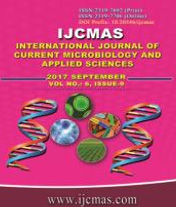


 National Academy of Agricultural Sciences (NAAS)
National Academy of Agricultural Sciences (NAAS)

|
PRINT ISSN : 2319-7692
Online ISSN : 2319-7706 Issues : 12 per year Publisher : Excellent Publishers Email : editorijcmas@gmail.com / submit@ijcmas.com Editor-in-chief: Dr.M.Prakash Index Copernicus ICV 2018: 95.39 NAAS RATING 2020: 5.38 |
A field experiment was carried out in the year 2014 and 2015 at experimental field of Banaras Hindu University, Varanasi, Uttar Pradesh, to evaluate the influence of mulching, nitrogen levels and weed management practices on direct seeded rice. Twenty-four treatment combinations consisting of two mulching viz. no mulch and live mulching (brown manuring with sesbania) and nitrogen levels (120 kg ha-1, 150 kg ha-1 and 180 kg ha-1) in main plot and four weed management practices viz. weedy check, two hand weeding at 20 and 40 DAS; azimsulfuron @ 30 g/ha + bispyribac-sodium @ 25 g/ha at 10-15 DAS; pendimethalin @ 1 kg/ha at 1-3 DAS fb bispyribac-sodium @ 25 g/ha 15-20 DAS were allocated to sub plots. It was observed that total weed dry weight at all the stages of observation was found to be significantly lower when brown manuring with sesbania was done under mulching. Under nitrogen levels, 180 kg ha-1 recorded highest while 120 kg ha-1 recorded lowest total weed dry weight. Treatment pendimethalin fb bispyribac- sodium @ 25 g/ha recorded lowest total weed dry weight under weed management practices. Weed control efficiency was observed higher under live mulching, 150 kg ha-1 and pendimethalin fb bispyribac- sodium @ 25 g/ha among mulching, nitrogen levels and weed management practices, respectively.
 |
 |
 |
 |
 |